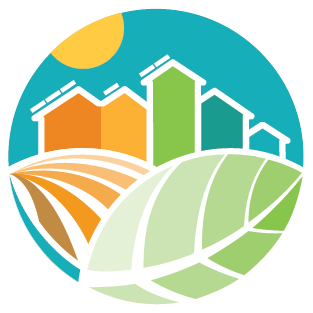What is Climate-Smart & Equitable Design?
Climate-smart construction and inclusive neighborhood design incorporates current best practices and new technologies focused on lowering greenhouse gas emissions, lowering energy consumption, and increasing resilience to extreme weather. Davis already is well known for some recommended elements of climate-smart design such as our community gardens, our walkable and bikeable neighborhoods, and our use of native plants. We can continue to be an innovative example by advocating for retrofits for existing neighborhoods and inclusion of the following in new developments.
In all future plans, Davis should continue prioritizing:
Community Gardens and Urban Agriculture: Encourage community gardens and urban agriculture to promote local, sustainable food production and native pollinator habitat.
Walkable and Bike-Friendly Neighborhoods: Design neighborhoods with walkable streets, bike lanes, and easy access to public transportation to center our streets around people (and reduce reliance on cars). These should be accessible in all areas of the community.
Efficient, Low-maintenance Landscaping: Choose native, drought-resistant plants to reduce water consumption. Increase the number of green spaces and parks with shaded areas, providing cool places for recreation and socializing. Promote landscaping that is low maintenance and supports diverse ecosystems, including spaces for pollinators.
Here are some suggestions for neighborhood designs, amenities, and elements that enhance safety in high heat that also align to our Climate Action and Adaptation Plan:
Cool Pavements and Permeable Pavement: Use cool pavements that reflect more sunlight and absorb less heat, reducing the urban heat island effect. Use permeable materials for driveways and sidewalks to reduce runoff and prevent our stormwater drains from overwhelming during intense rain, while supporting groundwater recharge.
Cooling Centers: Designate community buildings, such as libraries or community centers, as cooling centers during heatwaves, providing a refuge with air conditioning for those who need it. This is especially important for outdoor workers, people experiencing homelessness, seniors, people with disabilities, and those living in substandard housing.
Electrify homes: Go ALL ELECTRIC and Install Energy-Efficient Appliances: Choose appliances with high energy efficiency ratings. LED lighting, energy-efficient HVAC systems, and smart thermostats also contribute to energy savings. Phase out fossil gas from existing homes.
Energy-Efficient Windows and Insulation: Use high-quality windows and insulation to minimize heating and cooling energy needs.
Green Roofs or Cool Roofs on Public Buildings and Private Residences: Green roofs provide insulation, reduce stormwater runoff, and absorb CO2. They can also support local biodiversity. Incentivize cool roofing options to reduce the heat absorbed by the structures.
Heat Recovery Ventilation (HRV) Systems and High-Efficiency HVAC Systems: HRV systems recover heat from exhaust air and use it to preheat incoming fresh air, improving energy efficiency. If possible, upgrade to a high-efficiency HVAC systems such as heat-pumps that uses less energy while providing effective cooling and heating.
Increase and Maintain Urban Forestry: Plant a variety of shade trees that are heat tolerant along sidewalks, bike lanes and streets to provide natural shade and reduce pavement temperatures.
Micro Grids, Community Solar and storage, and Solar-Powered Charging Stations: Provide solar-powered charging stations for electronic devices and vehicles, allowing residents to stay connected during power outages and increase access to EVs in general.
Net-Zero Energy Homes: Build and retrofit homes to produce as much energy as they consume. Utilize a combination of energy-efficient design, insulation, and renewable energy sources.
Passive Solar Design: Incorporate passive solar principles in home design to maximize natural heating and cooling.
Prioritize Sustainable Materials: Choose eco-friendly and recycled materials in construction to reduce the environmental impact.
Shade Structures: Install shade structures, such as pergolas, awnings, or canopies, in public spaces, providing shelter from the sun. Trees are the ultimate shade structure and are effective in reducing the temperature of our streets on hot summer days.
Solar Panels: Install solar panels on roofs and over bike and car parking to generate clean, renewable energy. Battery storage systems can store excess energy for use later that day
Water Features: Incorporate water features like fountains or small ponds, which can have a cooling effect on the surrounding area.
In all cases, these innovations need to be made accessible to those in greatest need and who are bearing the costs of climate change. As we learn of new methods and innovations for climate-smart design, we will update this document. Have something you want to see added? Email us at info@daviscan.org

